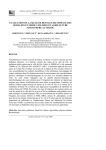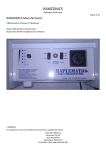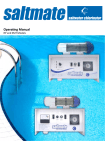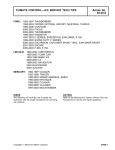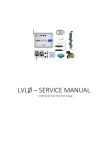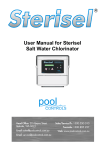Download TROUBLESHOOTING GUIDE – SALT CHLORINATORS
Transcript
TROUBLESHOOTING GUIDE – SALT CHLORINATORS No LED lights are lit There may be numerous reasons why the salt chlorinator LED does not light. Kindly check the following in an attempt to isolate the problem being experienced. Solution 1. Check that the 120/230V power supply is connected properly. Solution 2. Check that the transformer is properly connected to the power supply (see instruction manual diagram under section 4 - Electrical Assembly Step 2). New models: check that the red or green LED on the transformer is lit to ensure there is power. Note: this step does not apply to chlorinator models M5C/S5C. Solution 3. Check the 1 Amp transformer fuse and replace it if necessary. (see instruction manual diagram under section 4 Electrical Assembly Step 2). Note: this step does not apply to chlorinator models M5C/S5C. Solution 4. Check the 10 Amp fuse on the power supply and replace it if necessary. (see instruction manual diagram under section 1 - the Poolmaid salt chlorinator). Note: this step does not apply to chlorinator models M5C/S5C. Solution 5. For salt chlorinator models M5C/S5C, check the 1 Amp external fuse and replace it if necessary. Solution 6. If the transformer's fuse continues to trip, return the complete chlorinator unit to the manufacturer. The cell housing (10) can be closed with the additional blank electrode holder (6), which has been supplied with your chlorinator. Note: this step does not apply to chlorinator models M5C/S5C. Solution 7. For salt chlorinator models M5C/S5C, should the fuse on the power supply continue to trip, return the electrode and power supply to the manufacturer. The cell housing (10) can be closed with the additional blank electrode holder (6), which has been supplied with your chlorinator. Low salt indicator light is on There may be numerous reasons why the salt chlorinator low salt indicator light comes on. Kindly check the following in an attempt to isolate the problem being experienced. Solution 1. Add salt. For the M5C/S5C models add 50kg (110lbs) of rock or sea salt (with mo additives such as iodine). For other models add 100kg (220lbs) of rock or sea salt (with mo additives such as iodine). The low salt indicator should go off within 24 hours of adding the correct amount of salt. Solution 2. Check the cell and clean if necessary ONLY according to the method in the instruction manual under section 8 - Cell Maintenance. Note: the warranty will become null and void if the electrodes are NOT cleaned according to the above procedure. Solution 3. Ensure that adequate salt is replaced when filling or topping up the pool. Check to see whether the pool is leaking, resulting in abnormal water loss. Solution 4. If the low salt indicator remains lit, your electrodes may be faulty. Cell off indicator light is on Solution 1. Make sure the pool pump is running. Solution 2. Remove any debris in the filter's leaf trap. Solution 3. Check and repair any air leaks that may occur on the suction side of the system. Solution 4. Lubricate the O-ring and replace it if damaged. Solution 5. Ensure that the weir suction line is not blocked. Solution 6. Ensure that there is water flowing through the cell. Solution 7. Turn the electrode holder so that the gas sensor pin is located at the highest water level. Cell off indicator light flickers Solution 1. Turn the electrode holder so that the gas sensor pin is located at the highest water level. Solution 2. Make sure that there is no air in the cell housing by checking and repairing any air leaks on the suction side of the system. Solution 3. Lubricate the pump O-ring at the pump and replace it if damaged and check that there is sufficient water flow through the system and locate and repair any suction leaks. Too little or no chlorine is being produced Solution 1. If the following values are NOT correct your chlorinator will not produce sufficient chlorine. - ph: Gunite pool 7.2 - 7.6 ph: Vinyl/fibreglass pool 7.0 - 7.4 Total hardness: less than 400ppm Total alkalinity: 80 - 120ppm Salt: not less than 4000ppm (4 grams per litre) Stabiliser: 80 - 90ppm When adding stabiliser, please ensure that you backwash first, then pour the stabiliser in the weir, ensuring that the stabiliser passes through the filter first to avoid staining of your pool surface. Please do not backwash for 4 to 5 days. Solution 2. Ensure that the chlorinator is connected properly to the 120/230V supply. Solution 3. Ensure that the indicator lights are on. Solution 4. Ensure that the correct salt level indicator is lit. Solution 5. For the M5C/S5C models, press the keypad until the high light is lit. Solution 6. For models without temperature control, press the keypad until the maximum output setting on potion 5 is reached. Solution 7. If all of the above have been checked, test if the salt chlorinator is producing chlorine by doing the following: 1) switch off the pump and chlorinator 2) fill a plastic bucket with water from the pool 3) remove the electrode by unscrewing the ring nut, take care not to damage the O-ring 4) submerge the electrode in the bucket of pool water 5) take the blank electrode supplied and fit the O-ring from your existing electrode to it 6) fit it into the cell housing and screw the ring nut onto the cell housing 7) start the pump and chlorinator, running on maximum setting for 5 minutes 8) test for chlorine with a test strip or kit. A strong smell of chlorine should be present 9) switch off pump and chlorinator 10) remove blank and O-ring. Reassemble the electrode and run as normal 11) if chlorine is being produced, there may be a problem with the filter or sand filter 12) if the pool has been overdosed with algaecide, a reduced chlorine reading will result 13) ensure that fertiliser does not enter the pool as it can absorb chlorine 14) greater people/pool activity may reduce chlorine level. Increase the chlorine output. 15) if hydrogen peroxide has been added, it will be impossible to get reading for 14 days 16) dirt suspended in pool causes inefficient chemical action. Add flocculants as directed. There is a strong chlorine smell but no chlorine is measurable Solution 1. A strong smell of chlorine can indicate too little free chlorine in the water caused by organic matter. Increase the chlorine output. Eyes and skin become irritated Solution 1. Ensure that the ph level is correct. Solution 2. Ensure that the total hardness is below 400ppm. To reduce total hardness, drain some of the pool water and replace it with fresh water. Telephone: +27 11 662-4300 Facsimile: +27 11 662-4319 E-mail: [email protected] Internet: www.poolmaid .co.za PO BOX 522 Muldersdrift 1747, South Africa






